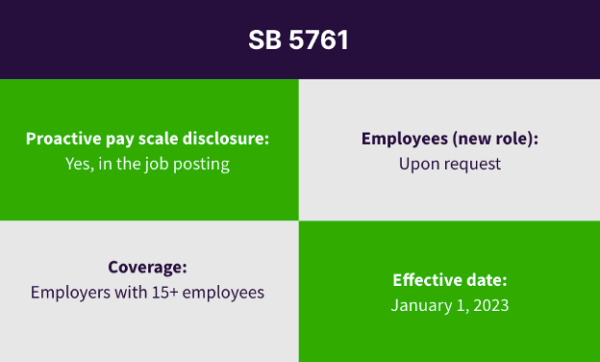In our recent Washington State Pay Scale Disclosure Law: What You Need to Know webinar, we reviewed what the amended Washington State pays scale disclosure law says about disclosing salary ranges and wage scales — and the impact it will have on employers. Here are some of the key questions and answers from the program to help you determine what you need to do.
Q: What does the Washington State salary range and wage scale transparency law require?
A: The amended law will require that companies include the pay range and a general description of all benefits and other compensation to be offered in all job postings. This requirement is effective January 1, 2023. Employees who are offered an internal transfer to a new position or a promotion can still request the pay scale for the new position, consistent with the current law.
Q: Does the law apply to all employers?
The law applies only to employers with 15+ employees.
Q: What is considered to be a “job posting”? Do I have to put salary ranges on my “Help Wanted” signs?
A: The law defines a “job posting” to be any solicitation intended to recruit a job applicant for a specific position. That means that if you post a general “Help Wanted” sign not tied to a specific role, it does not need to include the wage scale or salary range. If you are using a third-party, such as a third-party recruiter or sourcing firm, and the role is posted online — for example, on LinkedIn — or is posted other places on your behalf, then it does also need to include the range, plus the general description of benefits and other components of compensation. The law applies to any posting done electronically or with a printed hard copy, so long as it includes the qualifications for desired applicants.
Q: How is “wage scale or salary range” defined for the purposes of this law?
A: The law does not define these terms. The current pay scale law in Washington State, until the new law goes into effect in January, indicates that employers just need to provide the “minimum” wage or salary (and then only upon request). The new law will require employers to provide more than the minimum: they need to include a range and they need to put it in the job posting itself. Unlike many other pay scale disclosure laws — for example, the laws in NYC and Colorado — the Washington State amendment does not provide guidance as to how to define the range. Other laws have indicated that this needs to be the “reasonable” range. There may be more definition around what a “wage scale or salary range” means before the law takes effect. The Washington State Department of Labor & Industries indicated that it anticipates developing an administrative policy to help employers better understand the requirements of this legislation.
Q: What are the penalties for noncompliance?
A: Penalties include civil penalties ranging from $500 for a first violation to $1,000 or 10% of damages (whichever is greater) for a repeat violation; and statutory damages that are the greater of actual damages or $5,000; interest of 1% per month on all compensation owed; and costs and reasonable attorneys’ fees.
Q: How does this compare with the previous Washington State law?
A: The new law requires employers to proactively disclose the wage scale or salary range along with a general description of all benefits and other compensation in every job posting, rather than upon request as previously required. Employers also can no longer provide just a pay minimum but rather must post the pay scale or wage range.
Q: How does Washington State compare to other states in terms of pay transparency laws?
A: Washington State is:
- One of the first with more rigorous equal pay laws
- One of the first states to pass a mandatory pay transparency statute
- One of 6 jurisdictions that require including pay scale on job postings
The other jurisdictions that currently require pay scales on job postings are Colorado; New York City, NY; Washington State; Jersey City, NJ; Ithaca, NY; and Westchester County, NY. California, Chicago, and New York State — and more — are considering similar requirements.
Q: Is this a trend that employers should be planning for in states besides Washington?
A: We believe that we’re going to see continuing passage of these laws that require postings. If we look out a year or two from now, we think that it’s likely inevitable that employers are going to have to take a nationwide approach to transparency.
Q: What’s the trend nationwide for pay transparency laws?
A: So far we’re seeing three types of pay transparency laws:
- Pay scale information upon request; First, all of the laws started off in a reactive stance, which meant that you could access pay scale information, but only upon request. California, Washington State (before this amendment), Maryland, Cincinnati, and Toledo, Ohio, all passed these types of laws.
- Proactively providing pay scale information during the hiring process: To give a context of how quickly this is changing, just last year these pay scale disclosure laws morphed, and they morphed in a way that made them much more proactive. So instead of sitting back and waiting to see if anyone requested that information, which rarely happened, the laws changed to the second type, which is requiring that employers proactively provide that information at some point during the hiring process. The states that took this approach were Connecticut, Nevada, and Rhode Island.
- Proactively including pay scale information in job postings: Finally, we saw the third type in places like Colorado, where the law said not only do you have to provide pay scale information to the applicants who applied for the role and were in a stage of the hiring process, but you had to put that information on the actual job postings themselves. Currently six jurisdictions require including the pay scale on job postings. These jurisdictions are Colorado; New York City, NY; Washington State; Jersey City, NJ; Ithaca, NY; and Westchester County, NY. California, Chicago, and New York State — and more are considering similar requirements. This is a big change because since jobs are posted on the Internet, the information is available to your entire employee population who can look for salary ranges for jobs that are similar to or the same as their own. It also means the information will be available to peer companies.
You can read the specifics about what these different laws require and when they take effect in our Pay Transparency Legislation Cheat Sheet.
Communication about these laws will be critical. In a world increasingly defined by rigorous pay transparency, effective communications can make or break your brand. And whether you’re navigating stricter pay disclosure laws in Colorado, New York, Washington, or any state in between, the sooner you get started, the better off you’ll be. To help you prepare, Syndio CEO Maria Colacurcio partnered with Teresa Brewer, who’s led communications for some of the world’s most influential and disruptive brands including Apple, Sony, and Roblox, to offer guidance for your communications strategy in Comms 101: Your Median Pay Gap and the Transparency Era.
Want to learn more about how the Syndio platform can help you comply with the Washington State salary range and wage scale disclosure law?



